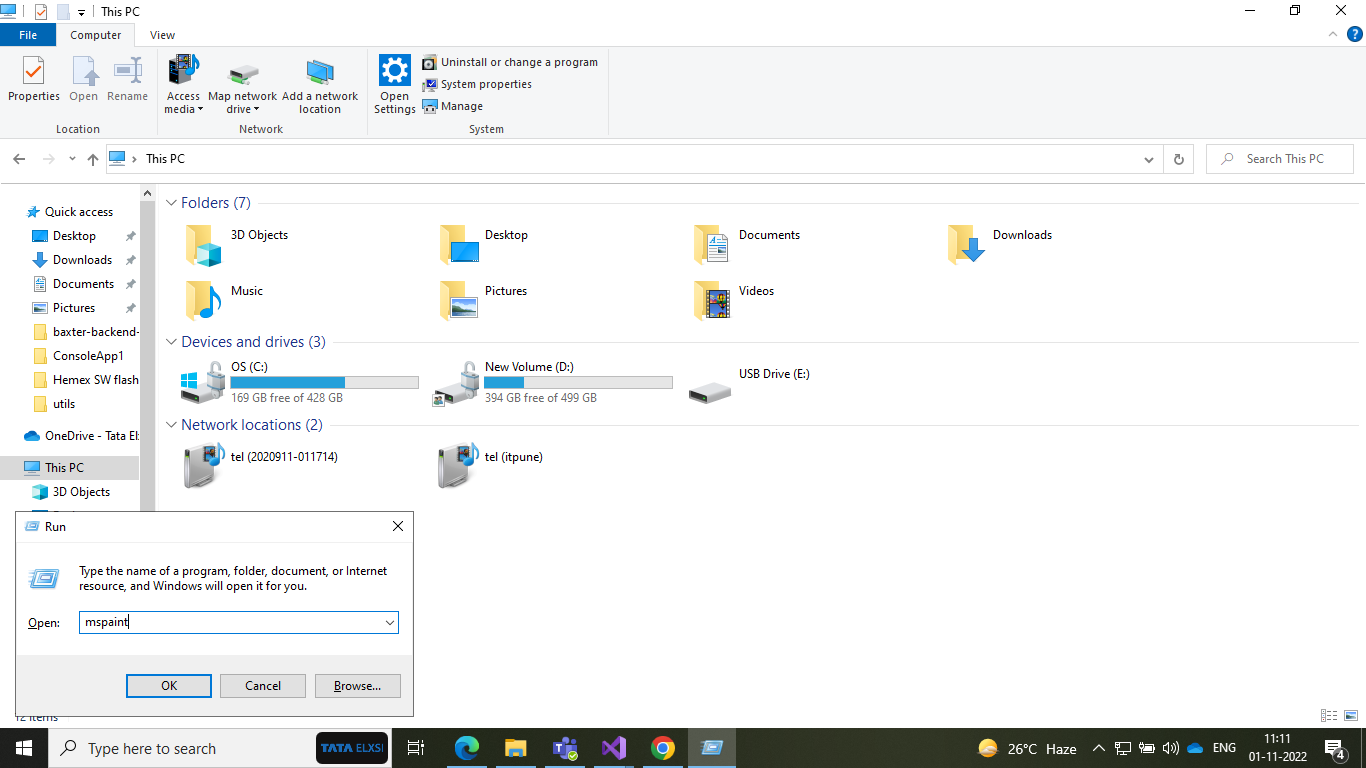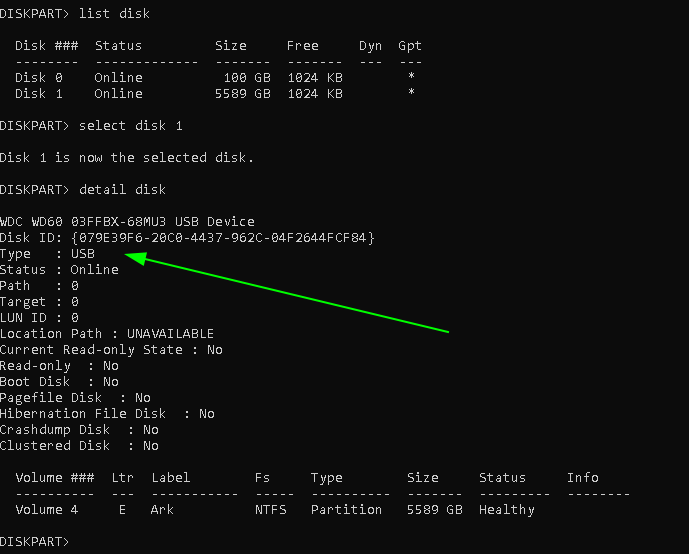如何从USB驱动器名中获取磁盘索引?请考虑带有分区和不带分区的USB。
我想要清理usb使用磁盘从C#。我已经写了下面的代码在C#得到所有连接的USB。在cmd命令下,我遍历所有usb并使用磁盘清除每个usb。
diskpart
list disk
select disk <0/1/2>
clean我想得到磁盘号码<0/1/2>从驱动器名称,以便我可以清理每个usb一个接一个。
foreach (DriveInfo drive in DriveInfo.GetDrives())
{
if (drive.IsReady == true)
{
if (drive.DriveType == DriveType.Removable)
{
string usbName = drive.Name;
}
}
}

回答 2
Stack Overflow用户
发布于 2022-11-01 03:32:42
以下说明如何使用ManagementObjectSearcher、ManagementObject检索可移动USB驱动器列表
Windows Forms App (.NET Framework) 创建项目
添加引用 (System.Management)
VS 2022年
- 单击项目
- 选择添加引用.
- 单击程序集
- 检查System.Management
- 单击OK
使用指令添加
using System.IO;using System.Management;using System.Diagnostics;
创建一个类(名称: LogicalDiskInfo)
public class LogicalDiskInfo : IComparable<LogicalDiskInfo>
{
public string Description { get; set; }
public string DeviceID { get; set; }
public uint DiskIndex { get; set; }
public uint DriveType { get; set; }
public string FileSystem { get; set; }
public bool IsRemovable { get; set; } = false;
public string Name { get; set; }
public uint PartitionIndex { get; set; }
public uint PartitionNumber { get; set; }
public UInt64 Size { get; set; }
public int CompareTo(LogicalDiskInfo other)
{
if (String.Compare(this.Name, other.Name) == 0)
return 0;
else if (String.Compare(this.Name, other.Name) < 0)
return -1;
else
return 1;
}
}创建一个类(名称: LogicalDisk)
public class LogicalDisk
{
public List<LogicalDiskInfo> LogicalDiskInfos = new List<LogicalDiskInfo>();
}创建一个类(名称: DiskDriveInfo)
public class DiskDriveInfo : IComparable<DiskDriveInfo>
{
public string Caption { get; set; } = string.Empty;
public string DeviceID { get; set; } = string.Empty;
public List<LogicalDiskInfo> LogicalDisks { get; set; } = new List<LogicalDiskInfo>();
public UInt32 DiskIndex { get; set; } = 0;
public string InterfaceType { get; set; } = string.Empty;
public bool IsRemovable { get; set; } = false;
public string MediaType { get; set; }
public string Model { get; set; } = string.Empty;
public string Name { get; set; } = string.Empty;
public UInt32 Partitions { get; set; } = 0;
public string PnpDeviceID { get; set; } = string.Empty;
public UInt64 Size { get; set; } = 0;
public string Status { get; set; } = string.Empty;
public int CompareTo(DiskDriveInfo other)
{
if (this.DiskIndex == other.DiskIndex)
return 0;
else if (this.DiskIndex < other.DiskIndex)
return -1;
else
return 1;
}
}GetUSBRemovableDiskDriveInfo:
备注:在Windows10中,可以在一个USB驱动器上创建多个分区。有关更多信息,请参见这里。因此,在同一个物理磁盘驱动器上可能存在多个驱动器号。下面的代码适用于具有单个分区或多个分区的USB驱动器。
private List<DiskDriveInfo> GetUSBRemovableDiskDriveInfo()
{
SortedDictionary<uint, DiskDriveInfo> diskDict = new SortedDictionary<uint, DiskDriveInfo>();
List<DiskDriveInfo> driveInfos = new List<DiskDriveInfo>();
//MediaType: 'Removable Media'
using (ManagementObjectSearcher searcherDiskDrive = new ManagementObjectSearcher("SELECT Caption, DeviceID, Index, InterfaceType, MediaType, Model, Name, Partitions, PNPDeviceID, Size, Status FROM Win32_DiskDrive WHERE InterfaceType='USB' and MediaType='Removable Media'"))
{
foreach (ManagementObject objDiskDrive in searcherDiskDrive.Get())
{
if (objDiskDrive == null)
continue;
//create new instance
DiskDriveInfo ddInfo = new DiskDriveInfo();
//set value
uint diskIndex = Convert.ToUInt32(objDiskDrive["Index"]);
ddInfo.Caption = objDiskDrive["Caption"]?.ToString();
ddInfo.DeviceID = objDiskDrive["DeviceID"]?.ToString();
ddInfo.DiskIndex = diskIndex;
ddInfo.InterfaceType = objDiskDrive["InterfaceType"]?.ToString();
ddInfo.MediaType = objDiskDrive["MediaType"]?.ToString();
ddInfo.Model = objDiskDrive["Model"]?.ToString();
ddInfo.Name = objDiskDrive["Name"]?.ToString();
ddInfo.Partitions = Convert.ToUInt32(objDiskDrive["Partitions"]);
ddInfo.PnpDeviceID = objDiskDrive["PnpDeviceID"]?.ToString();
ddInfo.Size = Convert.ToUInt64(objDiskDrive["Size"]);
ddInfo.Status = objDiskDrive["Status"]?.ToString();
if (ddInfo.MediaType == "Removable Media")
ddInfo.IsRemovable = true;
else
ddInfo.IsRemovable = false;
if (!diskDict.ContainsKey(diskIndex))
{
//Debug.WriteLine($"Adding DiskIndex {ddInfo.DiskIndex} Partitions: {ddInfo.Partitions}");
//add
diskDict.Add(diskIndex, ddInfo);
}
}
}
//create new instance
SortedDictionary<string, LogicalDisk> logicalDiskToPartitionDict = new SortedDictionary<string, LogicalDisk>();
//get info from Win32_LogicalDiskToPartition
//this is used to associate a DiskIndex and PartitionIndex with a drive letter
using (ManagementObjectSearcher searcherLogicalDiskToPartition = new ManagementObjectSearcher($@"SELECT * FROM Win32_LogicalDiskToPartition"))
{
foreach (ManagementObject objLogicalDiskToPartition in searcherLogicalDiskToPartition.Get())
{
if (objLogicalDiskToPartition == null)
continue;
string antecedent = objLogicalDiskToPartition["Antecedent"]?.ToString();
string dependent = objLogicalDiskToPartition["Dependent"]?.ToString();
string antecedentValue = antecedent.Substring(antecedent.IndexOf('=') + 1).Replace("\"", "");
uint diskIndex = 0;
uint partitionIndex = 0;
//get disk index and convert to uint
UInt32.TryParse(antecedentValue.Substring(antecedentValue.IndexOf("#") + 1, antecedentValue.IndexOf(",") - (antecedentValue.IndexOf("#") + 1)), out diskIndex);
//get partition index and convert to uint
UInt32.TryParse(antecedentValue.Substring(antecedentValue.LastIndexOf("#") + 1), out partitionIndex);
string driveLetter = dependent.Substring(dependent.IndexOf("=") + 1).Replace("\"", "");
if (diskDict.ContainsKey(diskIndex))
{
if (!logicalDiskToPartitionDict.ContainsKey(driveLetter))
{
//add
logicalDiskToPartitionDict.Add(driveLetter, new LogicalDisk());
}
//get info from Win32_LogicalDisk
using (ManagementObjectSearcher searcherLogicalDisk = new ManagementObjectSearcher($"SELECT Description, DeviceID, DriveType, FileSystem, Name, Size FROM Win32_LogicalDisk WHERE Name = '{driveLetter}'"))
{
foreach (ManagementObject objLogicalDisk in searcherLogicalDisk.Get())
{
if (objLogicalDisk == null)
continue;
//create new instance
LogicalDiskInfo logicalDiskInfo = new LogicalDiskInfo();
//set value
logicalDiskInfo.Description = objLogicalDisk["Description"]?.ToString();
logicalDiskInfo.DeviceID = objLogicalDisk["DeviceID"]?.ToString();
logicalDiskInfo.DriveType = Convert.ToUInt32(objLogicalDisk["DriveType"]);
logicalDiskInfo.DiskIndex = diskIndex;
logicalDiskInfo.FileSystem = objLogicalDisk["FileSystem"]?.ToString();
logicalDiskInfo.Name = objLogicalDisk["Name"]?.ToString();
logicalDiskInfo.PartitionIndex = partitionIndex;
logicalDiskInfo.PartitionNumber = partitionIndex + 1; //diskpart partitions start at 1
logicalDiskInfo.Size = Convert.ToUInt64(objLogicalDisk["Size"]);
//DriveType: 2=Removable; 3=Local Disk; 4=Network Drive; 5=CD
if (logicalDiskInfo.DriveType == 2)
logicalDiskInfo.IsRemovable = true;
else
logicalDiskInfo.IsRemovable = false;
Debug.WriteLine($"adding logicalDiskInfo for DiskIndex: '{diskIndex}' PartitionIndex: '{partitionIndex}' PartitionNumber: '{logicalDiskInfo.PartitionNumber}'");
//add
logicalDiskToPartitionDict[driveLetter].LogicalDiskInfos.Add(logicalDiskInfo);
}
}
}
}
}
//add logical disk info to disk dictionary
foreach(KeyValuePair<string, LogicalDisk> kvp in logicalDiskToPartitionDict)
{
List<LogicalDiskInfo> logicalDiskInfoList = kvp.Value.LogicalDiskInfos;
//sort
logicalDiskInfoList.Sort();
foreach (LogicalDiskInfo ldInfo in logicalDiskInfoList)
{
//add
diskDict[ldInfo.DiskIndex].LogicalDisks.Add(ldInfo);
}
}
//only add disks that are listed as 'Removable'
foreach(KeyValuePair<uint, DiskDriveInfo> kvp in diskDict)
{
if (kvp.Value.IsRemovable)
{
//add
driveInfos.Add(kvp.Value);
}
}
return driveInfos;
}使用
System.Diagnostics.Debug.WriteLine("--------GetUSBRemovableDiskDriveInfo----------");
foreach (DiskDriveInfo ddInfo in GetUSBRemovableDiskDriveInfo())
{
string driveLetters = string.Empty;
for (int i = 0; i < ddInfo.LogicalDisks.Count; i++)
{
if (i > 0)
driveLetters += ", ";
driveLetters += ddInfo.LogicalDisks[i].Name;
}
System.Diagnostics.Debug.WriteLine($"Caption: '{ddInfo.Caption}' Name: '{ddInfo.Name}' DiskIndex: '{ddInfo.DiskIndex}' DriveLetters: [{driveLetters}] Partitions: '{ddInfo.Partitions}' Size: '{ddInfo.Size}'");
}可以使用System.Diagnostics.Process执行盘片脚本来清理一个或多个磁盘。有关更多信息,请参见此帖子。
资源
Stack Overflow用户
发布于 2022-11-01 18:36:56
这可能是一种肮脏的方式,但是您可以交互地使用diskpart并发送命令/解析输出。由于我们无论如何都在调用diskpart,一个100%的托管代码库似乎不是目标,而是完成它的一种方法。
所以强调“肮脏”的方式,但也非常简单的功能方式:-)

有时,当有一个非常好的工作工具,如幽灵脚本或ffmpeg,我这样自动化他们。就像我在CMD提示下打字一样。
将CMD实例封装在要读取/写入的包装器中,然后在事件驱动的逻辑中驱动它。
using System;
using System.Diagnostics;
namespace yourapp
{
public class cmdShell
{
private Process shellProcess;
public delegate void onDataHandler(cmdShell sender, string e);
public event onDataHandler onData;
public cmdShell()
{
try
{
shellProcess = new Process();
ProcessStartInfo si = new ProcessStartInfo("cmd.exe");
si.Arguments = "/k";
si.RedirectStandardInput = true;
si.RedirectStandardOutput = true;
si.RedirectStandardError = true;
si.UseShellExecute = false;
si.CreateNoWindow = true;
si.WorkingDirectory = Environment.GetEnvironmentVariable("windir");
shellProcess.StartInfo = si;
shellProcess.OutputDataReceived += shellProcess_OutputDataReceived;
shellProcess.ErrorDataReceived += shellProcess_ErrorDataReceived;
shellProcess.Start();
shellProcess.BeginErrorReadLine();
shellProcess.BeginOutputReadLine();
}
catch (Exception ex)
{
Trace.WriteLine(ex.Message);
}
}
void shellProcess_ErrorDataReceived(object sender, DataReceivedEventArgs e)
{
doOnData(e.Data);
}
void shellProcess_OutputDataReceived(object sender, DataReceivedEventArgs e)
{
doOnData(e.Data);
}
private void doOnData(string data)
{
if (onData != null) onData(this, data);
}
public void write(string data)
{
try
{
shellProcess.StandardInput.WriteLine(data);
}
catch (Exception ex)
{
Trace.WriteLine(ex.Message);
}
}
}
}https://stackoverflow.com/questions/74261729
复制相似问题

